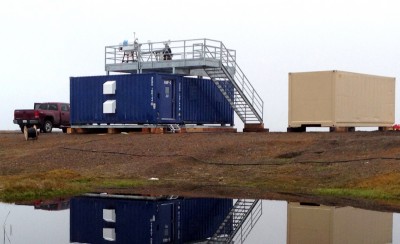Climate Data Now Flowing from Oliktok, Alaska
Published: 26 September 2013
New climate observatory records atmospheric measurements at intersection of Arctic land and sea.

Scientists seeking answers to questions about Arctic climate change will soon have a bevy of new data to mine from the North Slope of Alaska. In mid-September, a field team led by Sandia National Laboratories finished installing an initial collection of instruments at Oliktok Point, Alaska, for a new Department of Energy climate observation station. Initial measurements of clouds, aerosols, solar and thermal energy, and standard weather components are already flowing for use by the research community.
As the latest addition to the DOE’s Atmospheric Radiation Measurement (ARM) Climate Research Facility, the portable observatory is planned to operate for up to five years at its remote outpost near the U.S. Air Force’s Long Range Radar Site at Oliktok. It is ARM’s third mobile facility (AMF3) and the first one to operate for so long at a single location. It will complement data collected since 1997 by ARM’s long-term site in Barrow.
Cold Rush
On the North Slope, the seasonal window for large deployments like AMF3 is pretty slim: about five months. To meet the schedule for data flow by October 1, the Sandia team knew everything had to be done right with no delays. Fair weather—for the North Slope—helped them finish ahead of schedule, with first data collection beginning nearly two weeks early.
“The mood on the team started with excitement, then accomplishment, and now exhaustion,” said Sandia engineer Fred Helsel, the site manager for the AMF3.
Final instrument integration and testing took place at Sandia in Albuquerque, New Mexico, in May. From there, the focus turned to completing on-site infrastructure preparation and data system coordination. Everything came together successfully in August and September, just in time to beat the onset of the long, dark Arctic winter.

Primary considerations for the site included:
• highly insulated vans to conserve energy
• raised platforms to reduce snow accumulation
• arrangements for snow removal
• power and communications
• polar bear patrol.
Now the Sandia team is working to secure on-site “observers” for occasional monitoring and maintenance of the instruments at Oliktok. Possibilities include technical staff who maintain the USAF radar facilities, staff associated with the ARM Barrow facility, contracts with organizations that currently provide logistics support on the North Slope, and other ARM colleagues who have experience with field operations and might be interested in periodic rotations at Oliktok. Weather balloon operations are also planned for the future.
In addition to the Sandia team and local Alaskan support, about a dozen ARM colleagues from universities and other DOE national laboratories took part in various stages of the installation. More photos are available in the AMF3 image collection in Flickr.
Measurements at the Margins
Trends that point to a warming Arctic are well documented in climate records. Among them are the shrinking spread and year-to-year loss of sea-ice and temperatures rising at twice the rate of the rest of world. This second item in particular is leading to increasing instability in the region’s permafrost layer, which stores vast amounts of methane in its frozen grip—for now.
Scientists speculate a number of reasons for the changes, but the computer models they use to test their theories have yet to simulate these conditions with any level of accuracy. This is partly due to the difficulties in obtaining the needed observational data for the models.
With ARM’s two other mobile facilities booked out for several years due to high demand by the global science community, planning for the third AMF and its remote 5-year deployment began in earnest in 2012. However, long before that, ARM representatives had been in discussions with the USAF about the Oliktok site and the potential for conducting research flights by unmanned aerial systems (UAS) out over the Arctic sea ice.

The USAF radar station at Oliktok is one of several Cold-War era Distant Early Warning (DEW Line) radar sites. Its infrastructure includes several well-insulated modular buildings for living quarters and a hangar from the 1950s suitable for UAS operations.
Sandia has approval from the USAF for use of selected facilities to conduct scientific experiments for ARM in Restricted Airspace at Oliktok. In addition, the DOE has requested from the FAA the creation of a Warning Area for conducting UAS operations over international waters adjoining Oliktok. A Warning Area designation would alert pilots in the area of the potential for operations hazardous to aircraft, such as dropsondes, rocket-launched sondes, or tethered balloons.
The ability to use UAS at Oliktok will allow measurements of many critical Arctic systems and address gaps in scientific understanding of these processes. Two examples are mixed-phase cloud systems and the transition zone where land-locked ice thaws into the open sea—called the Marginal Ice Zone, or MIZ. This zone moves with the seasons and changes each year. The lack of data at this important intersection of land and sea exacerbates the already difficult modeling challenge. Fortunately, these kinds of difficulties are what the ARM Mobile Facilities were designed for.
The ARM Climate Research Facility is a DOE Office of Science user facility. The ARM Facility is operated by nine DOE national laboratories, including .
Keep up with the Atmospheric Observer
Updates on ARM news, events, and opportunities delivered to your inbox
ARM User Profile
ARM welcomes users from all institutions and nations. A free ARM user account is needed to access ARM data.


















